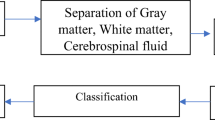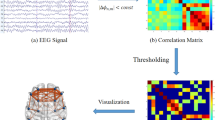Abstract
Schizophrenia is a type of serious mental illness. In clinical practice, it is still a challenging problem to identify schizophrenia-related brain patterns due to the lack of objective physiological data support and a unified data analysis method, physicians can only use the subjective experience to distinguish schizophrenia patients and healthy people, which may easily lead to misdiagnosis. In this study, we designed an optimized data-preprocessing method accompanied with techniques of general linear model feature extraction, independent sample t-test feature selection and support vector machine to identify a set of robust fNIRS pattern features as a biomarker to discriminate schizophrenia patients and healthy people. Experimental results demonstrated that the proposed combination way of data preprocessing, feature extraction, feature selection and support vector machine classification can effectively identify schizophrenia patients and the healthy people with a leave-one-out-cross-validation classification accuracy of 89.5%.













Similar content being viewed by others
References
Lynall ME, Bassett DS, Kerwin R et al (2010) Functional connectivity and brain networks in schizophrenia. J Neurosci Off J Soc Neurosci 30:9477–9487
Palaniyappan L, Mallikarjun P, Joseph V et al (2011) Folding of the prefrontal cortex in schizophrenia: regional differences in gyrification. Biol Psychiatry 69:974–979
Alexanderbloch AF, Vértes PE, Stidd R et al (2013) The anatomical distance of functional connections predicts brain network topology in healthy and schizophrenia. Cereb Cortex 23(1):127–138
Steen RG, Mull C, Mcclure R et al (2006) Brain volume in first-episode schizophrenia: systematic review and meta-analysis of magnetic resonance imaging studies. Br J Psychiatry 188(6):510–518
Sui J, Castro E, He H et al (2014) Combination of FMRI-SMRI-EEG data improves discrimination of schizophrenia patients by ensemble feature selection. In: 2014 36th Annual international conference of the IEEE Engineering in Medicine and Biology Society, IEEE, pp 3889–3892
Arbabshirani MR, Kiehl K, Pearlson G et al (2013) Classification of schizophrenia patients based on resting-state functional network connectivity. Front Neurosci 7:133
Castro E, Gómez-Verdejo V, Martínez-Ramón M et al (2014) A multiple kernel learning approach to perform classification of groups from complex-valued fMRI data analysis: application to schizophrenia. NeuroImage 87:1–17
Kamran MA, Mannan MMN, Jeong MY (2016) Cortical signal analysis and advances in functional near-infrared spectroscopy signal: a review. Front Hum Neurosci 10:261–272
Zephaniah PV, Kim JG (2014) Recent functional near infrared spectroscopy based brain computer interface systems: developments, applications and challenges. Biomed Eng Lett 4(3):223–230
Obrig H, Villringer A (2003) Beyond the visible—imaging the human brain with light. J Cereb Blood Flow Metab Off J Int Soc Cereb Blood Flow Metab 23:1–18
Logothetis NK, Wandell BA (2004) Interpreting the BOLD signal. Annu Rev Physiol 66:735–769
Ehlis AC, Schneider S, Dresler T et al (2014) Application of functional near-infrared spectroscopy in psychiatry. Neuroimage 85:478–488
Takizawa R, Kasai K, Kawakubo Y et al (2008) Reduced frontopolar activation during verbal fluency task in schizophrenia: a multi-channel near-infrared spectroscopy study. Schizophr Res 99(1–3):250–262
Koike S, Nishimura Y, Takizawa R et al (2013) Near-infrared spectroscopy in schizophrenia: a possible biomarker for predicting clinical outcome and treatment response. Front Psychiatry 4:145
Dadgostar M, Setarehdan SK, Shahzadi S et al (2018) Classification of schizophrenia using SVM via fNIRS. Biomed Eng Appl Basis Commun 30(02):1850008
Li Z, Wang Y, Quan W et al (2015) Evaluation of different classification methods for the diagnosis of schizophrenia based on functional near-infrared spectroscopy. J Neurosci Methods 241:101–110
Azechi M, Iwase M, Ikezawa K et al (2010) Discriminant analysis in schizophrenia and healthy subjects using prefrontal activation during frontal lobe tasks: a near-infrared spectroscopy. Schizophr Res 117(1):52–60
Song H, Bogdan IIM, Wang S et al (2016) Automatic schizophrenia discrimination on fnirs by using pca and svm. In: 2016 IEEE international conference on bioinformatics and biomedicine (BIBM), IEEE, pp 389–394
Swinehart DF (1962) The Beer–Lambert law. J Chem Educ 39(7):333
Song H, Chen L, Gao RQ et al (2017) Automatic schizophrenic discrimination on fNIRS by using complex brain network analysis and SVM. BMC Med Inform Decis Mak 17(3):166
Kiebel SJ, Mueller K (2015) The general linear model. Brain Mapp 25:465–469
Shen XP, Ding JS, Li JS (2007) 2-Independent-samples t-test undertaking by the means of mean and standard deviation in spss. Mod Prev Med 34(21):4066–4069
Suykens JAK, Vandewalle J (1999) Least squares support vector machine classifiers. Neural Process Lett 9:293–300
Xuegong Z (2000) Introduction to statistical learning theory and support vector machines. Acta Automatica Sinica 26(1):32–42
Fung GM, Mangasarian OL (2005) Multicategory proximal support vector machine classifiers. Mach Learn 59(1–2):77–97
Amari S, Wu S (1999) Improving support vector machine classifiers by modifying kernel functions. Neural Netw 12(6):783–789
Garrett D, Peterson DA, Anderson CW, Thaut MH (2003) Comparison of linear, nonlinear, and feature selection methods for eeg signal classification. IEEE Trans Neural Syst Rehabil Eng 11(2):141–144
Wang S, Gwizdka J, Chovalitwongse WA (2016) Using wireless eeg signals to assess memory workload in the n-back task. IEEE Trans Hum Mach Syst 46(3):424–435
Kaper M, Meinicke P, Grossekathoefer U, Lingner T, Ritter H (2004) Bci competition 2003-data set iib: support vector machines for the p300 speller paradigm. IEEE Trans Biomed Eng 51(6):1073–1076
Blankertz B, Curio G, Muller K (2002) Classifying single trial eeg: towards brain computer interfacing. Adv Neural Inf Process Syst 14(2):157–164
Chang CC, Lin CJ (2011) LIBSVM: a library for support vector machines. ACM Trans Intell Syst Technol 2:1–27. https://www.csie.ntu.edu.tw/~cjlin/libsvm/
Cawley GC, Talbot NLC (2003) Efficient leave-one-out cross-validation of kernel fisher discriminant classifiers. Pattern Recognit 36(11):2585–2592
Cawley GC, Talbot NLC (2004) Fast exact leave-one-out cross-validation of sparse least-squares support vector machines. Neural Netw 17(10):1467–1475
Acknowledgements
This work was supported by National Key R&D Program of China (2017YFC0110700) and National Natural Science Foundation of China (61771056).
Author information
Authors and Affiliations
Corresponding author
Ethics declarations
Conflict of interest
The authors declare that they have no conflict of interest.
Ethical approval
This study was approved by the ethics review committee of Peking University Sixth Hospital.
Informed consent
This study was consented by all the patients.
Additional information
Publisher's Note
Springer Nature remains neutral with regard to jurisdictional claims in published maps and institutional affiliations.
Rights and permissions
About this article
Cite this article
Chen, L., Li, Q., Song, H. et al. Classification of schizophrenia using general linear model and support vector machine via fNIRS. Phys Eng Sci Med 43, 1151–1160 (2020). https://doi.org/10.1007/s13246-020-00920-0
Received:
Accepted:
Published:
Issue Date:
DOI: https://doi.org/10.1007/s13246-020-00920-0




